
Installation and operating instructions Wilo-Sub TWU 3-...-HS (High Speed) 13
INSTALLATION English
4.4 Return delivery
Pumps that are returned to the factory must be
properly packaged. This means that impurities
have been removed from the pump and that it has
been decontaminated if used with fluids that are
hazardous to health.
For shipping, the parts must be packed in tear-
proof plastic bags of sufficient size in such a
manner that they are tightly sealed and leak-
proof. Furthermore, the packaging must protect
the pump from damage during transportation.
If you have any questions, please contact the
manufacturer!
5 Installation
In order to prevent damage to the device or seri-
ous injury during installation, note:
• Installation work – assembly and installation
of the submersible pump – may only be carried
out by qualified persons by following the safety
instructions at all times.
• The submersible pump should be inspected for
transport damage before any installation work is
carried out.
5.1 General
In the event of pumping through longer discharge
pipelines (particularly in the case of longer as-
cending pipes), pressure surges can occur.
Pressure surges can result in destruction of
the pump/system and noise pollution due to
flap knock. Water hammers can be reduced or
prevented by applying suitable measures (e.g.
non-return valves with an adjustable closing time,
electrically actuated shut-off devices, special
routing of the discharge pipeline).
If you are using a level control device, make sure
that the minimum water coverage is present. Air
pockets in the hydraulic housing or pipe system
must be avoided at all costs and must be removed
using a suitable ventilation system. Protect the
submersible pump from frost.
5.2 Installation types
• Vertical stationary installation, immersed
•
Horizontal stationary installation, immersed –
only in conjunction with a cooling jacket!
5.3 Installation
DANGER of falling!
When installing the pump and its accesso-
ries, work is sometimes performed directly at
the edge of the well or tank. Carelessness or
wearing inappropriate clothing could result
in a fall. There is a risk of fatal injury! Take all
necessary safety precautions to prevent this.
When installing the pump, note the following:
•
This work must be performed by qualified per
-
sonnel and electrical work must be performed by
a qualified electrician.
• The operating space must be clean, free of coarse
solids, dry, frost-free and, if necessary, decon-
taminated and suitable for the particular pump.
There must be sufficient water inflow for the
submersible pump's maximum output in order to
prevent dry run and/or air intake.
• When working in tanks, wells or boreholes, a sec-
ond person must be present for safety reasons.
Take the necessary countermeasures if there is a
risk of toxic or suffocating gases collecting!
•
Ensure that lifting equipment can be fitted with
-
out any trouble, since this is required for assem-
bly/dismantling of the pump. It must be possible
to reach the pump safely in its operating and
storage locations using the lifting equipment. The
set-down location must have a solid bearing sur-
face. For transporting the pump, the lifting gear
must be secured to the prescribed lifting eyelets.
When using chains, these must be connected to
the lifting eyes using a shackle. Lifting gear must
be technically approved.
• Power supply cables must be laid out in such a
way that safe operation and trouble-free instal-
lation/dismantling are possible at all times. The
pump must never be carried or dragged by the
power supply cable. Check whether the cable
present is long enough for its cross-section and
its installation type.
• When using switchgear, the corresponding pro-
tection class should be observed. Switchgears are
to be generally arranged overflow-proof.
• Structural components and foundations must be
of sufficient stability in order to allow the product
to be fixed securely and functionally. The opera
-
tor or the supplier is responsible for provision of
the foundations and their suitability in terms of
dimensions, stability and strength!
• Check that the available design documentation
(installation plans, layout of the operating space,
intake ratios) is complete and correct.
• Also refer to all regulations, rules and laws for
working with heavy and suspended loads. Wear
appropriate protective clothing/equipment.
• Please also observe the applicable national acci-
dent prevention regulations and trade association
safety provisions.













































